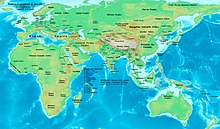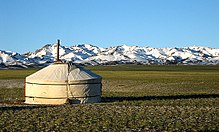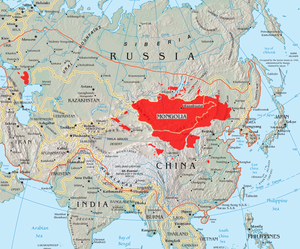Mongols: Difference between revisions
No edit summary |
edit style |
||
| Line 5: | Line 5: | ||
{{Infobox Ethnic group| |
{{Infobox Ethnic group| |
||
|group=Mongols |
|group=Mongols |
||
|image= [[File:Balingiin Tserendorj.jpg|68px|B.Tserendorj]][[Image:Sukhe-bator.jpg|68px|D. Sükhbaatar]][[File:Byambyn Rinchen.jpg|67px]]<br>[[Image: |
|image= [[File:Balingiin Tserendorj.jpg|68px|B.Tserendorj]][[Image:Sukhe-bator.jpg|68px|D. Sükhbaatar]][[File:Byambyn Rinchen.jpg|67px]]<br>[[Image:YesheDorje.jpg|68px|Zanabazar]][[Image:Danzanravjaa statue.JPG|68px|Danzanravjaa]][[File: Batumongke Dayan Khaan.jpg|68px|Batumongke Dayan Khan]]<br>[[Image:Yanjmaa1.jpg|54px|Yanjmaa]][[Image:YuanEmperorAlbumGenghisPortrait.jpg|70px|Genghis Khan|Genghis Khan]][[Image:Anandyn Amar2.jpg|77px|A.Amar]]<small><br>[[Balingiin Tserendorj|B. Tserendorj]] • [[Damdin Sükhbaatar|D.Sükhbaatar]] • [[Byambyn Rinchen|B. Rinchen]] <br/> [[Zanabazar]] • [[Danzanravjaa]] • [[Batumongke Dayan Khan]]<br>[[Sükhbaataryn Yanjmaa|Yanjmaa]] • [[Genghis Khan]] • [[Anandyn Amar|A. Amar]]• |
||
|poptime=~10,000,000<br><small>(~0.16% of the world population)</small> |
|poptime=~10,000,000<br><small>(~0.16% of the world population)</small> |
||
|region1 = {{flag|China}} |
|region1 = {{flag|China}} |
||
Revision as of 15:36, 28 September 2009
    DanzanravjaaBatumongke Dayan Khan DanzanravjaaBatumongke Dayan KhanYanjmaa   B. Tserendorj • D.Sükhbaatar • B. Rinchen Zanabazar • Danzanravjaa • Batumongke Dayan Khan Yanjmaa • Genghis Khan • A. Amar• | |
| Regions with significant populations | |
|---|---|
| ~5,800,000[1] | |
| ~2,700,000 | |
| ~1,000,000 | |
| Languages | |
| Predominantly Mongolic languages; also Chinese, Russian. | |
| Religion | |
| Tibetan Buddhism and Shamanism.[1][2] Small Christian and Muslim groups exist. | |
| Related ethnic groups | |
| Khalkha, Daur, Buryats,Tuvans, Hazara, Dörbed, Kalmyks, Oirats, Chahar, Tümed, Moghols, Aimak, Ordos, Bayad, Dariganga, Uriankhai, Üzemchin, Zakhchin | |
The name Mongol (Mongolian: ![]() Mongγol; Cyrillic script: Mongol) specifies one or several ethnic groups, now mainly located in Mongolia, China, and Russia.
Mongγol; Cyrillic script: Mongol) specifies one or several ethnic groups, now mainly located in Mongolia, China, and Russia.
Definition
A narrow definition includes the Mongols proper, which can be roughly divided into eastern and western Mongols. In a wider sense, the Mongol people includes all people who speak a Mongolic language, such as the Kalmyks of eastern Europe.
The name "Mongol" appeared first in 8th century records of the Chinese Tang dynasty as a tribe of Shiwei, but then only resurfaced in the 11th century during the rule of the Khitan. At first it was applied to some small and still insignificant tribes in the area of the Onon River. After the fall of Liao Dynasty in 1125, the Mongols became a leading steppe tribe. However, their wars with the Jin Dynasty and Tatars weakened them severely. In the 13th century, it grew into an umbrella term for a large group of Mongolic and Turkic tribes united under the rule of Genghis Khan under a same identity (mostly cultural).[3]
History
Based on Chinese historical texts the ancestry of the Mongol peoples can be traced back to the Donghu, a nomadic confederation occupying eastern Mongolia and Manchuria, who were defeated by Modu Shanyu of the Xiongnu after he became Emperor in 209 B.C. The identity of the Xiongnu is still debated today. Although some scholars maintain that they were proto-Mongols, the fact that Chinese histories trace certain Turkic tribes from the Xiongnu complicates the issue.[4] The Donghu, however, can be much more easily labeled proto-Mongol since the Chinese histories exclusively trace all the subsequent Mongolic tribes and kingdoms (mainly Xianbei peoples) from them, although some historical texts claim a mixed Xiongnu-Donghu ancestry for some tribes (e.g. in the case of the proto-Mongolic Khitan).[5]

Three prominent proto-Mongol groups split from the Xianbei, as recorded by the Chinese histories: the Rouran (claimed by some to be the Avars), the Khitan and the Shiwei (a sub-tribe called the "Shiwei Menggu" is held to be the origin of the Genghisid Mongols).[6] Their culture was basically nomadic, their religion Shamanism or Buddhism and their military strength formidable. There is still no direct evidence that the Rouran spoke a Mongolic language, although most scholars agree that they were proto-Mongolic.[7] The Khitan, however, had two scripts of their own and many distinctly Mongolic words are found in their half-deciphered writings that are usually found with a parallel Chinese text (for example, nair=sun, sair=moon, tau=five, jau=hundred, m.r=horse, im.a=goat, n.q=dog, m.ng=silver, u.ul=winter, tau.l.a=rabbit, t.q.a=hen and m.g.o=snake).[8] There is generally no doubt regarding the Khitan being proto-Mongol.[9]

Geographically the Tuoba Xianbei ruled Inner Mongolia and northern China, the Rouran (Yujiulu Shelun was the first to use the title Khagan in 402) ruled Outer Mongolia, the Khitan were concentrated in Southern Manchuria north of Korea and the Shiwei were located to the north of the Khitan. These tribes and kingdoms were soon overshadowed by the rise of the Gok-Turks in 555, the Uyghurs in 745 and the Kyrgyzs in 840. The Tuoba were eventually absorbed into China. The Rouran fled west from the Gok-Turks and either disappeared into obscurity or, as some say, invaded Europe as the Avars. The Khitan, who were practically independent after their separation from the proto-Mongol Kumo Xi in 388 A.D, continued as a minor power in Manchuria until one of them, Abaoji (872-926), established the Khitan Liao Dynasty (907-1125 A.D). The Khitan fled west after their defeat by the Tungusic Jurchens and founded the Kara-Khitan or Western Liao dynasty (1125-1218 A.D) in eastern Kazakhstan. In 1218 Genghis Khan destroyed the Kara-Khitan Kingdom after which the Khitan passed into obscurity. The modern-day minority of Mongolic-speaking Daurs in China are their direct descendants based on DNA evidence.[10][11]
The Shiwei included a tribe called the Shiwei Menggu.[12] Bodonchir Munkhag (c. 970 A.D) the founder of the House of Borjigin and the ancestor of Genghis Khan is held to be descended from the Shiwei Menggu. The first historically recorded involvement of the Shiwei Mongols in foreign affairs is from the 1130s when there were reciprocally hostile relations between the successive khans of the Khamag Mongol confederation (Qaidu I, Khabul Khan and Ambaghai) and the emperors of the Jin dynasty, the details of which are mainly recorded in the Secret History of the Mongols.[citation needed]
With the expansion of the Mongol Empire, the Mongols settled almost all over Eurasia and carried on military campaigns from the Adriatic Sea to Java and from Japan to Israel. Mongols simultaneously became Tsars of Russia, Padishahs of Persia, Emperors of China, Great Khans of Mongolia and one Mongol even became Sultan of Egypt (Al-Adil Kitbugha). With the breakup of the Empire, the dispersed Mongols quickly adopted the mostly Turkish cultures surrounding them and got assimilated, forming parts of Tatars (not confused with a tribe in ancient Mongolia), Uzbeks, Kazakhs, Yugurs and Moghuls. However, most of the Mongols returned to Mongolia, retaining their language and culture. After the fall of the Yuan Dynasty in 1368 the Mongols established their independent regime as Northern Yuan. However, the Oirads or Western Mongols began to challenge the Eastern Mongols under the Borjigin monarchs in the late 14th century.
Present-day Khalkha Mongols and Inner Mongolians are the most prominent of the remaining Eastern Mongols while the Kalmyks in Europe are the main descendants of the Western Mongols. The Khalkha emerged during the reign of Dayan Khan (1464-1543) as one of the seven tumens of the Eastern Mongols. They quickly became the dominant Mongol clan in Outer Mongolia.[13][14]
Language

The specific origin of the Mongolic languages and associated tribes is unclear. Some researchers have proposed a link to languages like Tungusic and Turkic, which are often included alongside Mongolic in a hypothetical group called Altaic languages, but this grouping is controversial.
Physical characteristics
In terms of physical characteristics Mongolians exhibit a variety of features. The typical Asian features are undoubtedly dominant. Contrary to preconceptions, flat noses are rather rare among Khalkha or Outer Mongolians. Instead, modestly long noses are far more common, with the occasional aquiline nose appearing frequently as well. Height and leg length vary from very short to very tall. Hair is typically Asian, straight and coarse, with body hair minimal. Skin color is very light brown. But long exposure to the sun can make it a very dark brown. A significant number of Mongolians exhibit extraordinarily light skin similar to whites, in addition to "white" features like light to blond hair, blue or green eyes, hairiness and prominent nose to varying degrees. Some have reddish-light brown hair, pink face and small green eyes. Yet the nose-bridge rarely reaches the "full" prominence of whites, and epicanthic folds on the eye are ubiquitous. In fact, classic "small eyes" are perhaps the single most dominant characteristic among Mongolians, distinguishing them from Southern Chinese and South East Asians. Almost all Mongolians with blond hair, coloured eyes and very light skin have small eyes. Certain Mongolians exhibit pronounced short stature, broad face, flat nose and jutting cheekbones. Y Haplogroup C3 (Y-DNA) is prevalent among Mongolians, although haplogroups R1a and J (western genes) are also to be found, probably explained by historical proximity to the Tocharians and Uyghurs.[citation needed]
Geographic distribution

Today, people of Mongol origin live in Mongolia, China (Inner Mongolia), Russia, and a few other central Asian countries.
The differentiation between tribes and peoples (nationalities) is handled differently depending on the country. The Tumed, Chahar, Ordos, Bargut (or Barga), Buryats, Dörböd (Dörvöd, Dörbed), Torguud, Dariganga, Üzemchin (or Üzümchin), Bayid, Khoton, Myangad (Mingad), Zakhchin (Zakchin), Darkhad, and Oirats (or Öölds or Ölöts) are all counted as tribes of the Mongols.
Mongolia
The population of Mongolia consists of 92.6% Mongols, numbering approximately 2.7 million. From the middle ages to early modern period the Khalkha, Uriankhai and Buryats were counted as eastern Mongols while the Oirats, living mainly in the Altay region, belonged to the western Mongols.
China
The Chinese census of 2000 counted 5.8 million Mongols, according to the narrow definition above. It should be noted that 1992 census of China counted only 3.6 million Mongols. Most of them live in the Inner Mongolia autonomous region, followed by Liaoning province. Small numbers can also be found in provinces near those two.
Other peoples speaking Mongolic languages are the Daur, Monguor, Dongxiang, Bonan, and parts of the Yugur. Those do not officially count as part of the Mongol nationality, but are recognized as nationalities of their own.
Russia
In Russia, the Buriats belong to the eastern Mongols. The western Mongols include the Oirats in the Russian Altay and the Kalmyks at the northern side of the Caspian Sea, where they make up 53.3% of the population of Russia's autonomous province of Kalmykia.[15]. The Tuva and the Altay people are culturally close to Mongols, but speak Turkic languages. Together they amount to roughly a million people.
Gallery
-
A Mongolian musician
-
A mongolian girl
-
Dongxiang boys
-
Kalmyks
-
Altan Khan of the Tumed
-
Dagvadorj Dolgorsuren (Asashoryu)
-
Mongolian girl performing Bayad dance
See also
References
- ^ a b The Mongolian Ethnic Group (China.org.cn June 21, 2005)
- ^ China Mongolian, Mongol Ethnic Minority, Mongols History, Food
- ^ "Mongolia: Ethnography of Mongolia". Encyclopædia Britannica. Retrieved 2007-07-22..
{{cite web}}: Check date values in:|accessdate=(help) - ^ John Man-Attila: the barbarian king who challenged Rome, p.38
- ^ Frances Wood-The Silk Road: two thousand years in the heart of Asia, p.48
- ^ University of California, Berkeley. Project on Linguistic Analysis-Journal of Chinese linguistics, p.154
- ^ Thomas Hoppe-Die ethnischen Gruppen Xinjiangs: Kulturunterschiede und interethnische, p.66
- ^ Frederick W. Mote-Imperial China 900-1800 - p.405
- ^ Herbert Franke, John King Fairbank, Denis Crispin Twitchett, Roderick MacFarquhar, Denis Twitchett, Albert Feuerwerker. vol.3-The Cambridge History of China, p.364
- ^ Uradyn Erden Bulag-The Mongols at China's edge: history and the politics of national unity, p.167
- ^ Ruofu Du, Vincent F. Yip-Ethnic groups in China, p.27
- ^ Paul Ratchnevsky, Thomas Nivison Haining-Genghis Khan: his life and legacy, p.7
- ^ Juha Janhunen-The Mongolic languages, p.177
- ^ Elizabeth E. Bacon-Obok: A Study of Social Structure in Eurasia, p.82
- ^ "Kalmyks". World Directory of Minorities and Indigenous Peoples. 2005. Retrieved 2008-05-18.






